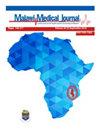马拉维一家主要烧伤科的成人烧伤:流行病学和与长期住院有关的因素
IF 0.8
4区 医学
Q4 PUBLIC, ENVIRONMENTAL & OCCUPATIONAL HEALTH
引用次数: 0
摘要
目的本研究旨在描述伊丽莎白女王中心医院烧伤科收治的成年患者的烧伤流行病学和延长住院时间的相关因素。方法回顾2007年6月1日至2017年5月31日在伊丽莎白女王中心医院烧伤科收治的所有17岁以上急性烧伤患者的档案。从档案中提取了有关社会人口统计学特征、持续损伤、合并症、住院时间和临床结果的数据。计算汇总统计量、独立样本t检验和比值比来确定所收集变量的分布和关联。结果共审查了515例来自农村或非正规城市住区的患者档案。就诊时的中位年龄为32岁(IQR: 25-45), 52% (n=279)为男性。大部分烧伤发生在家中(81.0%;N =379),火焰病因占75.7%;N =385),报告为意外(94.7%,N =445)。月平均新发烧伤病例率在冷干季节最高,癫痫发作是常见的烧伤病例(30.7%;n = 158)。大多数(62.7%)烧伤部位记录的患者为多发烧伤,超过一半的患者有上肢和下肢烧伤(64.6% &59.5%)。30名患者持续了额外的非烧伤,记录结果的所有患者中有26.4% (n=132)在医院死亡。结论:在QECH烧伤科就诊的成人烧伤数据表明,存在与烧伤发病率相关的社会经济不平等。还需要改善初级保健设施中癫痫治疗的质量和接受程度。本文章由计算机程序翻译,如有差异,请以英文原文为准。
Burns among adults in a major Malawian burn unit: epidemiology and factors associated with prolonged hospital stay
AimThis study sought to describe the epidemiology of burns and factors associated with prolonged hospital stay among adult patients admitted in the Queen Elizabeth Central Hospital burns unit. MethodsAll files of patients aged at least 17 years and admitted in the Queen Elizabeth Central Hospital burns unit between 1 June 2007 and 31 May 2017 with acute burns, were reviewed. Data on socio-demographic characteristics, injuries sustained, comorbidities, length of hospital stay, and clinical outcomes were extracted from the files. Summary statistics, independent sample T-test, and odds ratios were computed to determine the distribution and associations of the variables collected.Results A total of 515 patient files, all from rural or informal urban settlements, were reviewed. The median age at the time of presentation was 32 years (IQR: 25-45), and 52% (n=279) were male. Most of the burns occurred at home (81.0%; n=379), were of flame etiology (75.7%; n=385), and were reported to have been accidental (94.7%, n=445). The mean monthly rate of new burn injury patients was highest in the cool-dry season, and epileptic seizures were a common precedent of burn injury (30.7%; n=158). Most (62.7%) of the patients with recorded burn sites sustained multiple burns injuries, and more than half of the patients had upper and lower limb burns (64.6% & 59.5% respectively). Thirty patients sustained additional non-burn injuries, and 26.4% (n=132) of all patients with recorded outcomes died in the hospital.Conclusion The data on burn injuries among adults presenting at the QECH burns unit suggests the existence of socio-economic inequalities associated with burn incidence. There is also a need for improvement in the quality and uptake of epilepsy care in primary care facilities.
求助全文
通过发布文献求助,成功后即可免费获取论文全文。
去求助
来源期刊

Malawi Medical Journal
Medicine-General Medicine
CiteScore
1.50
自引率
0.00%
发文量
27
审稿时长
>12 weeks
期刊介绍:
Driven and guided by the priorities articulated in the Malawi National Health Research Agenda, the Malawi Medical Journal publishes original research, short reports, case reports, viewpoints, insightful editorials and commentaries that are of high quality, informative and applicable to the Malawian and sub-Saharan Africa regions. Our particular interest is to publish evidence-based research that impacts and informs national health policies and medical practice in Malawi and the broader region.
Topics covered in the journal include, but are not limited to:
- Communicable diseases (HIV and AIDS, Malaria, TB, etc.)
- Non-communicable diseases (Cardiovascular diseases, cancer, diabetes, etc.)
- Sexual and Reproductive Health (Adolescent health, education, pregnancy and abortion, STDs and HIV and AIDS, etc.)
- Mental health
- Environmental health
- Nutrition
- Health systems and health policy (Leadership, ethics, and governance)
- Community systems strengthening research
- Injury, trauma, and surgical disorders
 求助内容:
求助内容: 应助结果提醒方式:
应助结果提醒方式:


